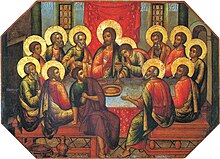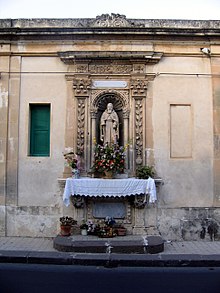Adoration of saints
The veneration of saints is the honoring remembrance of individual people (" saints "), of whom a denomination assumes that they were called to holiness and led an exemplary or holy life or fulfilled the criteria for canonization by the denomination.
Forms of veneration of saints exist within Christianity in the Roman Catholic Church , the Eastern Churches , the Anglican Church, and some Protestant denominations ; in addition also in Hinduism and in Buddhism , in Islam and in Judaism .
Christianity
Bible
In the New Testament, people as saints are almost always spoken of in the plural (the only exception: John the Baptist as a “righteous and holy man” ( Mk 6.20 EU )). Christians are called saints; B. the apostle Paul writes "to the saints in Rome" ( Rom 1,7 EU ).
Some scriptures - which do not use the term “saints” - are used as references to the veneration of saints, such as 1 Cor 12:26 (“When a member is honored, all others rejoice with him”), Heb. 13: 7 (“Think to your rulers, who preached the word of God to you; look to the end of their lives and imitate their faith "), Rev 6,9 (" the souls of all who were slaughtered because of the word of God and because of the testimony, that they had discarded ").
Roman Catholic and Orthodox Church

The veneration of saints ( Latin veneratio , also Dulia , Greek δουλεία, douleia ) is in the Roman Catholic and Orthodox churches the solemn honor of a person and thereby the glorification of God himself, who created the "holy" person (in his image) , accepted with grace, richly endowed with charisms and completed within themselves at the end of their earthly life. The veneration of the grace of God seen realized in the saints is often expressed outwardly in a form of respectful bowing to an icon or relic , usually associated with the sign of the cross ; also a kiss of the icon or relic, a mutual kiss of peace or some other culturally appropriate way of showing honor and respect can take place. The procession of relics is also a form of worship . There is no duty to worship saints in the Roman Catholic Church. The veneration of saints is closely related to the concept of the communion of saints , to which all Christians testify in the Apostles' Creed .
Saints have a day of remembrance in the general or regional liturgical calendar . Usually it is the day of their death ("birthday in heaven"). On this day, the saint is commemorated in the liturgical texts of Holy Mass and the Liturgy of the Hours . The many unknown and unrecognized saints the Church commemorates the feast of All Saints .
Places (churches, mountains, springs), devotional objects and times (holidays, fasting days) can also be regarded as "holy" insofar as they or through them honor God. All churches, whether they practice the veneration of saints or not, maintain that worship is due only to God .
Lutheran churches
The concept of veneration of saints can be interpreted very broadly, so the differences must be observed: The honorable memory of the work of extraordinary people hardly meets with objections. The Lutheran churches profess to commemorate the saints in the Augsburg Confession . Article 21 states that faith will be strengthened when the Church sees God show grace on the saints. The Church of today should take an example from the good works of the saints. An invocation of the saints is refused until today, "because there is only one reconciler and mediator set between God and man, Jesus Christ ( 1 Tim 2,5 LUT )" (21st article of the Augsburg Confession). The Independent Evangelical Lutheran Church commemorates the saints on November 1st, the day of the saints' remembrance .
Evangelical criticism
In Protestant theology, the majority of the Roman Catholic and Orthodox Churches reject the veneration of saints as unbiblical and criticize the fact that the veneration of people and the worship of God are mixed up. In this context, Roman Catholic theology emphasizes that saints are not worshiped, but merely called upon for their intercession with God. Protestant theologians such as Wyclif , Martin Luther or John Calvin saw the invocation of saints as mediators to God impaired trust in Jesus Christ as the only mediator between God and man ( 1 Tim 2,5 EU ).
See also
- Adoration of Mary , list of the blessed and saints , calendar of saints , popular piety , votive offering
- Holiness in islam
literature
in alphabetical order by authors / editors
- Sabine Komm: Holy tombs of the 11th and 12th centuries in France. Research on typology and worship of graves (= manuscripts for art history in the Werner publishing company 27). Wernersche Verlagsgesellschaft, Worms 1990, ISBN 978-3-88462-926-0 .
- Wolfgang Kosack : The Coptic calendar of saints. German - Coptic - Arabic based on the best sources, revised and completely published with Index Sanctorum Coptic Saints, Index of Names in Coptic, Coptic Patriarchal List, Geographical List. Christoph Brunner, Berlin 2012, ISBN 978-3-9524018-4-2 .
- Ernst Lucius: The beginnings of the cult of saints in the Christian church. Edited by G. Anrich, Tübingen 1904.
- Gerhard Ludwig Müller : adoration of saints. In: Christian Schütz (Ed.): Practical Lexicon of Spirituality. Herder, Freiburg i.Br. u. a. 1992, ISBN 3-451-22614-6 , Sp. 594-597.
- Wiebke Schulz-Wackerbarth: Adoration of saints in late antique and early medieval Rome. Hagiography and topography in discourse (= contexts. New contributions to historical and systematic theology Volume 47.) Edition Ruprecht, Göttingen 2020, ISBN 978-3-8469-0286-8 .
Web links
Single receipts
- ↑ Announcements of the Apostolic See No. 160 (December 17, 2001), Directory on Popular Piety and the Liturgy, No. 211, 212.
- ^ Franz Stuhlhofer : Praying to saints? Asslar 1988.
